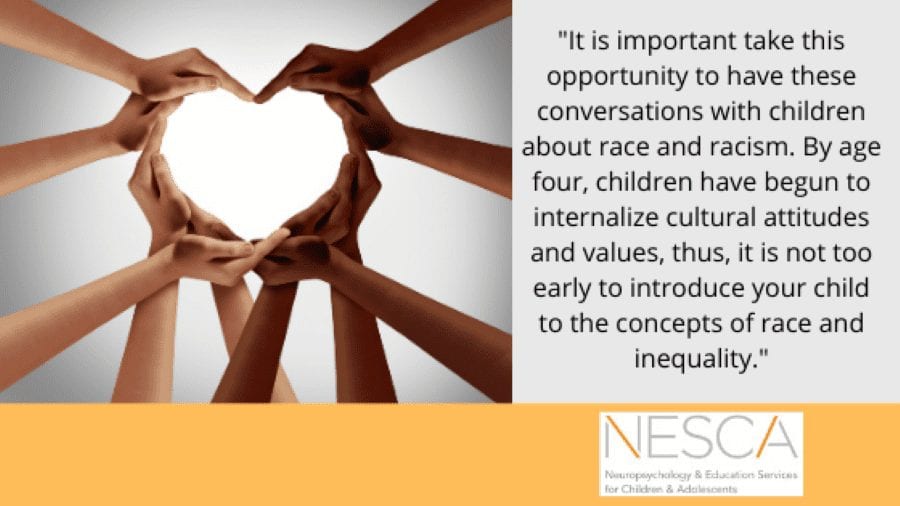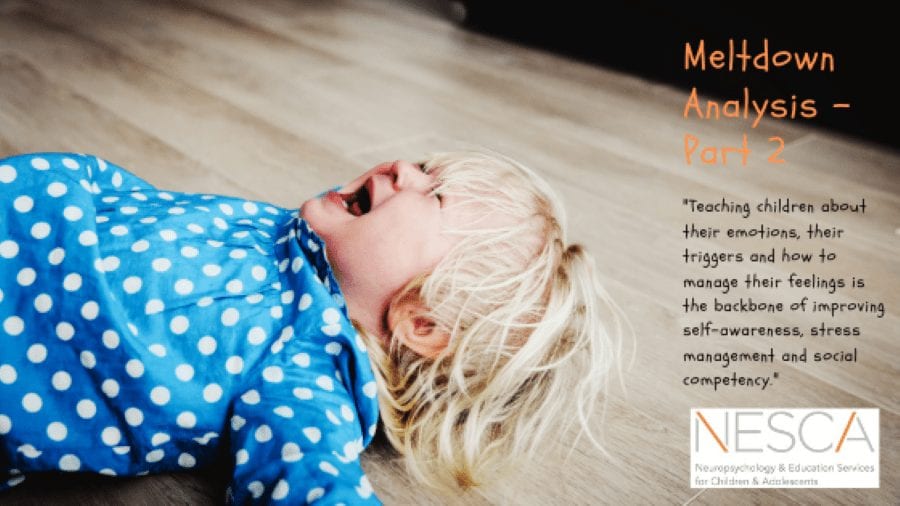

By: Cynthia Hess, PsyD
Pediatric Neuropsychologist Fellow and Therapist
It is old news that parents and children have been experiencing an increased sense of uncertainty and vulnerability due to COVID-19. That vulnerability may be exacerbated by the news of violent protests that were sparked by anger over police brutality against black men and women. News of widespread violence around the country spread rapidly in a country already stressed to its capacity in dealing with a global pandemic and the resulting economic hardship. In the aftermath of these recent tragedies, parents should be aware that children may be experiencing collateral consequences, such as fear, anxiety and confusion. Rhea Boyd, MD, MPH, stated, “Whether from social media accounts, conversations with peers or caregivers, overheard conversations, or the distress they witness in the faces of those they love, children know what is going on. And without the guidance and validation of their caregivers, they may be navigating their feelings alone.” So, what do we do?
First, take care of yourself. Now is a good time to practice self-compassion and selfcare. The stress of watching traumatic events on television and smartphones “lingers within our bodies and minds,” states developmental pediatrician Dr. Jenny Radesky. Recognize that vicarious trauma is real, and even if you have not been directly affected, you may be experiencing heightened anxiety, difficulty sleeping, fatigue or increased irritability. Practice accepting your own feelings, instead of controlling them. Go for a walk, talk with a friend, practice relaxation techniques or do something you enjoy.
It is important to consider how we talk with children. While children from birth to age three do not understand what is happening, they can feel it through the reactions of the adults around them. You may notice that your young child has become more irritable, or perhaps crying more than usual. In addition to calming your child, limit the amount of time you spend accessing unsettling news reports in the presence of young children.
With elementary children, it is wise to begin your discussion with, “tell me what you know.” By elementary age, children have a good idea about what is happening. Asking children what they know and following up with any questions they might have will help you to provide age appropriate information. It is important to keep channels of communication open, because as time passes it is likely more questions will arise. Children may want to know that they are safe and, if they ask, provide reassurance. With that being said, limit their exposure to media, be it on television, tablet or smartphone. If they are accessing media, be aware of what they are watching and learning. Answer questions as appropriate and, as with all ages, validate their feelings and assure them that whatever they are feeling, it is okay.
It is probable that teenage youth have seen the images and been involved in learning about the events that precipitated the violence that unfolded. They may even be getting involved in activism by posting and re-posting social media messages. Teenagers often process events by talking with their peers, and it can, at times, be difficult to engage them in conversation. Approach the topic with your teen from a position of curiosity. What do they know? How do they know it? How do they feel about it? It is also a good time for you and your teen to become more educated about the history of racism in our country and how it has been perpetuated through generations of people. A broader societal context of racism will help youth have a better understanding of the anger seen in the demonstrations. A documentary called “13th,” about the 13th amendment, takes an in-depth look at the prison system in the United States and how it mirrors the nation’s history of racial inequality. It is both educational and provides a starting point for having conversations about race with your teen. Additionally, as much as possible, be aware of your teen’s online activity. There is a lot of misinformation and inflammatory rhetoric on social media, and teens need guidance on how to be thoughtful and responsible consumers of all types of media.
Given that the recent unrest was sparked by anger over police brutality against black people, it is important take this opportunity to have these conversations with children about race and racism. By age four, children have begun to internalize cultural attitudes and values, thus, it is not too early to introduce your child to the concepts of race and inequality. Books that include multi-racial characters are a good way to introduce children to people of color in a positive light. Common Sense Media has a list of books appropriate for kids of all ages beginning in infancy, and the link is provided below.
Experts stress that parents also need to give their children the broader societal context of racism to try to explain the rage of protestors filling the streets of cities across the nation. Doing so helps build empathy and teach perspective-taking, shifting the focus from the child’s specific fears. Helping children to view events from different perspectives provides understanding and promotes empathy. When your child sees something on television, YouTube or social media, employ a sense of curiosity. Ask them what they saw, how they felt about what they saw, and have them think about and share how they think different people involved in the situation felt. Dr. Radesky suggests, “Instead of focusing on questions the child may have about concrete things, ask them questions like ‘How do you think those people were feeling? Do you know why they were angry? What do you do when you feel like something is unfair?’” We all have our different perspectives regarding racism and the complex history of race in our country. Providing space for children to ask questions, discuss their feelings and process the world around them will help them cope with the myriad emotions that may arise due to current events and the sense of helplessness and fear they may be experiencing.
Some helpful resources:
https://www.pbs.org/parents/authors/jenny-radesky-md
https://www.commonsensemedia.org/lists/books-with-characters-of-color
https://www.commonsensemedia.org/blog/black-history-movies-that-tackle-racism
https://www.commonsensemedia.org/lists/movies-that-inspire-kids-to-change-the-world
https://pediatrics.aappublications.org/content/144/2/e20191765
About the Author
Dr. Cynthia Hess recently graduated from Rivier University with a PsyD in Counseling and School Psychology. Previously, she earned an  M.A. from Antioch New England in Applied Psychology. She also worked as an elementary school counselor and school psychologist for 15 years before embarking on her doctorate. During her doctorate, she did her pre-doctoral internship with RIT in Rochester, N.Y. where she worked with youth ages 5-17 who had experienced complex developmental trauma. Dr. Hess’s first post-doctoral fellowship was with The Counseling Center of New England where she provided psychotherapy and family therapy to children ages 5-18, their families and young adults. She also trained part-time with a pediatric neuropsychologist conducting neuropsychological evaluations. Currently, Dr. Hess is a second-year post-doctoral fellow in pediatric neuropsychological assessment, working with NESCA Londonderry’s Dr. Angela Currie.
M.A. from Antioch New England in Applied Psychology. She also worked as an elementary school counselor and school psychologist for 15 years before embarking on her doctorate. During her doctorate, she did her pre-doctoral internship with RIT in Rochester, N.Y. where she worked with youth ages 5-17 who had experienced complex developmental trauma. Dr. Hess’s first post-doctoral fellowship was with The Counseling Center of New England where she provided psychotherapy and family therapy to children ages 5-18, their families and young adults. She also trained part-time with a pediatric neuropsychologist conducting neuropsychological evaluations. Currently, Dr. Hess is a second-year post-doctoral fellow in pediatric neuropsychological assessment, working with NESCA Londonderry’s Dr. Angela Currie.
To schedule an appointment with one of NESCA’s expert neuropsychologists, please complete our online intake form.
Neuropsychology & Education Services for Children & Adolescents (NESCA) is a pediatric neuropsychology practice and integrative treatment center with offices in Newton and Plainville, Massachusetts, and Londonderry, New Hampshire, serving clients from preschool through young adulthood and their families. For more information, please email info@nesca-newton.com or call 617-658-9800.




 and academia for over 30 years. She is a national consultant and speaker on program design and the inclusion of children and adolescents with special needs, especially those diagnosed with Autism Spectrum Disorder (ASD). Prior to joining NESCA, Ms. Lucci was the Principal of the Partners Program/EDCO Collaborative and previously the Program Director and Director of Consultation at MGH/Aspire for 13 years, where she built child, teen and young adult programs and established the 3-Ss (self-awareness, social competency and stress management) as the programming backbone. She also served as director of the Autism Support Center. Ms. Lucci was previously an elementary classroom teacher, special educator, researcher, school psychologist, college professor and director of public schools, a private special education school and an education collaborative.
and academia for over 30 years. She is a national consultant and speaker on program design and the inclusion of children and adolescents with special needs, especially those diagnosed with Autism Spectrum Disorder (ASD). Prior to joining NESCA, Ms. Lucci was the Principal of the Partners Program/EDCO Collaborative and previously the Program Director and Director of Consultation at MGH/Aspire for 13 years, where she built child, teen and young adult programs and established the 3-Ss (self-awareness, social competency and stress management) as the programming backbone. She also served as director of the Autism Support Center. Ms. Lucci was previously an elementary classroom teacher, special educator, researcher, school psychologist, college professor and director of public schools, a private special education school and an education collaborative.








Connect with Us